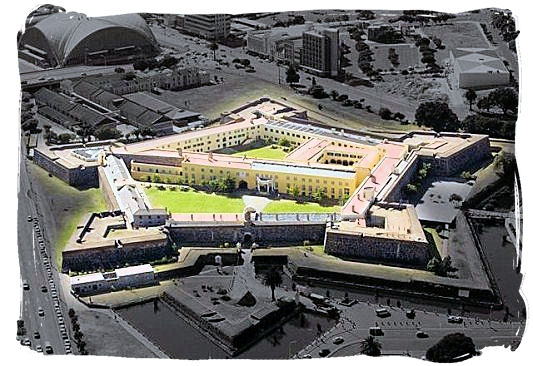
Q:
When was the Castle of Good Hope built?
A:
The Castle of Good Hope was built between 1666-1679.
Q:
Did Jan van Riebeeck build the Castle?
A:
No. Jan van Riebeeck built a four pointed Clay and Timber Fort, which was
situated close to the now Golden Acre in the Cape Town CBD. See plan of
Fort.
Q: What
materials were used to build the Castle?
A:
Stone was cut from the granite outcrop on Signal Hill. Stone was further broken
by men with hammers and piled up in readiness for conveyance to the new site.
Blue slate and shells were transported from Robben Island. Shells were burned to
obtain lime, which was mixed in ratio 1:1 with building clay for use as mortar.
Q:
Who built the Castle of Good Hope?
A:
Soldiers, slaves and a few Khoina undergoing punishment for having offended
against the settlers and even a few volunteers.
Q:
Why was the Castle of Good Hope built?
A:
During long slow trips between Europe and the East, many crewmen fell ill and
died, as the result of deficiency diseases caused by lack of fresh food. The VOC
clearly required a replenisment station on their long voyages half-way round the
world. Table Bay was chosen and Commander Jan van Riebeeck and his pioneers were
to make gardens to produce fresh vegetables and trade with livestock with the
indigenous Khoina, whom they were forbidden to molest or enslave. The four
pointed clay and timber Fort was the first building to be erected in 1652 and
was upon suggestion by Jan van Riebeeck to be replaced by a more permanent
structure that could withstand the natural elements and protect its interests
against possible attack from its potential enemies. Four years after Commander Jan van
Riebeeck left the Cape in 1662, the Castle of Good Hope was built and completed
in 1679.
Q:
Who was the "VOC"?
A:
It was a trading company known as the Vereenighde Oost-Indische Compagnie (VOC)
established in 1602. In that year the States General, highest authority in the
United Netherlands, granted a charter that, among other powers, conferred on the
VOC the right to enter into treaties in the name of the State General, to raise
and maintain an army and a fleet, and to ensure good order, control and justice.
The charter also provided that no other subjects of the Netherlands may trade
from the east of the Cape of Good Hope to the Straits of Magellan. Control of
the VOC was vested in six chambers, each of which was represented in the central
controlling body, known as the Lords Seventeen. Each chamber may build trading
ships, although the loss of a ship was shared by all.
Q:
What are the names of the Five(5) bastions of the Castle?
A:
Leerdam, Buuren, Catzenellenbogen, Nassau and Oranje. These were named after the
titles of Prince William of Orange (Prins Willem van Oranje).
Q:
Why are the flags flown on the Leerdam Bastion?
A:
Flags were initially flown on the Catzenellenbogen Bastion as it was the closest
bastion to the sea and was used for signal purposes to relay messages from the
Castle and abroad. Today the flags are visible on the Leerdam Bastion and
indicate the different reigns of government during the past four
centuries.
Q:
Was the Castle of Good Hope ever attacked?
A:
No the Castle was never attacked. Battles against the British were fought at Muizenberg in
1795 and Blaauwberg in
1806.
Q:
Did the sea ever wash up against the Castle walls?
A:
Yes. In fact during terrible storms in the 17th century, the sea would wash-up
against the Castle walls where Strand Street is currently situated. This
resulted the moving of the initial Castle main entrance (current entrance to
Castle Military Museum) to its present location (where the bell tower is
situated). In 1745 the Imhoff Battery was built and was known as the couvre-face
Imhoff. The Battery was later cut-off from the Castle by the first railway
line into Cape Town, and was later demolished to make room for the highway that
is today known as Strand Street.
Q:
Are there ghosts at the Castle of Good Hope?
A:
Various people have indicated that they have seen ghosts at the Castle and this
is not uncommon. Ghosts, it is said, are likely to be found in places where
their material bodies were violently torn from life, or returning to old
familiar places to complete forgotten assignments. The Castle had time enough to
gather a host of ghosts, and its walls and dungeons have known terrifying
cruelty. These and more stories can be read in the Castle Publication
("Castle of Good Hope from 1666" by B. Johnson Barker) on sale at the
Castle Military Museum.
Q:
Who and what was the "Council of Policy"?
A:
The Council of Policy was the highest authority of the VOC at the Cape of Good
Hope. The Council discussed all problems that arose and took decisions on
governing the settlement. The minutes, which include reports and decisions
taken, are called the Resolutions of the Council of
Policy. For nearly
one and a half centuries the Council of Policy wrote millions of word on
thousands of folio pages about matters concerning everyday life at the Cape. The
Resolutions cover nearly every subject, for example administration, justice, law
and order, education, religion, inhabitants, slaves, visitors, ships and their
cargo, the military, health services, food, labour, trade (imports, exports and
trading with the indigenous peoples), diplomatic relations, expeditions, weather
conditions on and off shore, agricultural activities, livestock, nature
conservation, land issues, loan-farms and fiscal and financial matters. The
Resolutions are the main source of written accounts of pre-modern South Africa.
For tours and more information visit: www.castleofgoodhope.co.za
No comments:
Post a Comment